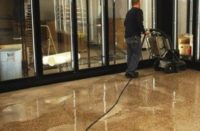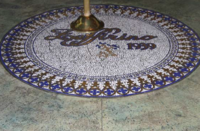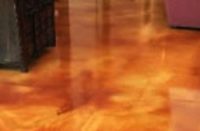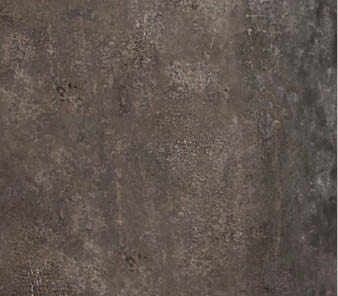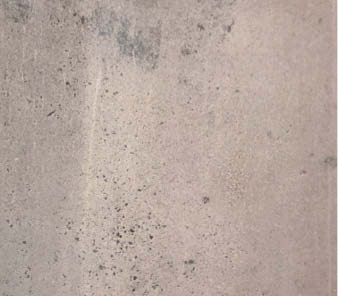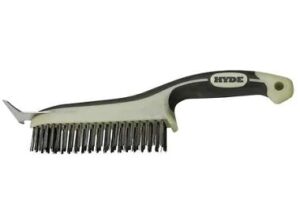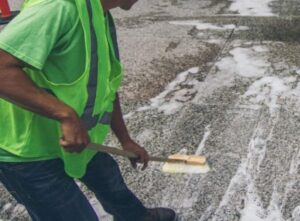
Preparing concrete correctly before applying a coating helps to ensure the coating’s success. Contractors must carefully evaluate the substrate and its condition to determine what cleaner or degreaser is needed for cleaning concrete. They must also take care in how to properly apply it.
“The objective in preparation is to get the concrete back to its purest state so the substrate will be closer to the original,” says Mark Hampston, CEO of Redi-Mix Colors in Taunton, Massachusetts. Proper prepping helps reduce contaminants before your next step.
“There are a number of factors to consider: the age of the concrete and what it’s been subjected to. If it’s foot traffic, it’s easier to clean. If it’s heavy traffic, you may need some grinding. Then a sealing product is needed before you do the top coat,” he says.
Moisture is also an issue that needs to be solved before moving forward with the coating. “Sometimes you need a deep-penetrating sealer, which mitigates any potential future moisture from the bottom up,” says Hampston.
“In many cases, cleaning and preparation with deep-penetrating cleaners doesn’t get enough attention and the epoxy or urethane isn’t allowed the opportunity to bond as it should. You need to eliminate the moisture and prevent it from returning.”
Matching the cleaners with the surface and the grime
In determining the right cleaner, it’s important to know the makeup of the surface you’re trying to clean and what you’re trying to remove from it.
“For polished concrete you have to have a specific cleaner,” says Greg Cabot, digital marketing manager of Ameripolish in Lowell, Arkansas. “If you use an aggressive cleaner, you could alter the overall appearance and aesthetic qualities of the concrete and even discolor dyes,” he says.
Using the wrong cleaner can create new unwanted issues, he notes. “It can potentially leave behind residue or a contaminant, like oil, which needs a specific type of cleaner to be removed entirely. Most cleaners do not remove oil. It may appear to be gone, but it could cause issues for adhering a coating to the surface.”
Different substrates require different types of cleaners. “The most important thing is to know your substrate. Once you know that, you can go about selecting the proper cleaner for that substrate,” says Jeff Bonkiewicz, channel manager at Laticrete International in Bethany, Connecticut. “In our Stonetech line of products, there are several different sealers, enhancers, and cleaners, each designed for specific substrates.”
The next steps
Once you know your substrate, the type of grime you need to remove becomes a factor in choosing the right cleaner. “Certain floor contaminants can be difficult. In polished concrete, if vinegar or wine has been on the surface for some time, there really is no cleaning agent that can take it out. It will likely leave a shadow behind even after thorough cleaning,” says Bonkiewicz.
He notes that floors must be maintained to remain in good condition. “A good maintenance floor plan is vital to the health of the floor, especially for commercial and institutional floors,” says Bonkiewicz.
“We have a maintenance plan for our FGS PermaShine polished concrete system, which includes using a concentrated cleaning agent designed specifically for polished concrete. For Spartacote resinous flooring, we require a mechanical profile before the resinous coating gets applied.”
Mechanically preparing a surface with a grinder gets off any mastics or surface contaminants. These things can act as a bond breaker between the concrete and the resinous coating, Bonkiewicz adds.
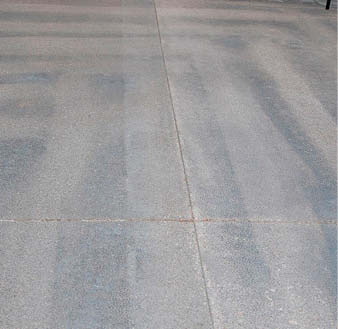 |
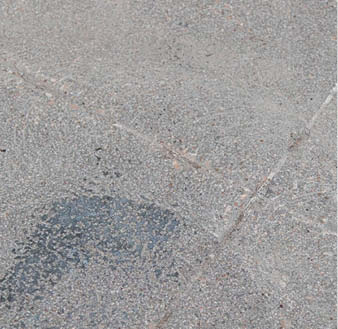 |
Using an all-purpose cleaner
Some contractors work with an all-purpose cleaner that’s adjusted in strength to accommodate different types of grime that needs to be removed. “Our cleaner is concentrated, so the end-user can use it in a number of dilutions depending on the application,” says Scott Sarver, marketing coordinator at Franmar Chemical in Bloomington, Illinois.
“For general cleaning purposes after mastic removal or to prep concrete for resealing or painting, 4 ounces to a gallon of water is recommended. The concentrate can be mixed at a higher ratio for washers and floor machines or even (used) full strength.”
While an all-purpose cleaner may be appropriate for indoor surfaces, outdoor substrates may require a different cleaner. “We also have an exterior surface cleaner to clean concrete, stonework, brick and other hard surfaces that have become dirty over time,” says Sarver. “This exterior cleaner helps restore these surfaces to their original appearance.”
Out in the field, contractors teach their workers to prepare the concrete correctly so the coatings will work. “Before we put down any of our coatings we have to prepare the concrete right. Either that or the coating will fail,” says Aaron Statser, general manager at Business Flooring Specialists in Houston, Texas.
“As for using the right cleaner, we typically use Redi-Mix Colors. When we use that we don’t have to worry about leaving any residue behind. When we get oil out of the concrete, we don’t have to worry about leaving a stain behind. I know we’ll get a clean surface,” Statser says.
Applying the cleaner or degreaser
Once you have identified the substrate and grime, and have chosen the appropriate cleaner, application becomes the next issue in preparing the surface.
“How you apply the cleaner depends on the chemical you’re using. Some are spray-on, some are scrub-in, some need to be flooded and then reapplied until a stain is gone. Others need to be diluted in a concentrate and used with an automatic scrubber,” says Ameripolish’s Cabot. “Stains and contaminants can be different in different scenarios because concrete slabs differ from one another.”
At Redi-Mix Colors, “Our products are best sprayed on. An improper application can alter the topcoat by not getting it clean enough, not protecting against moisture or not opening the concrete enough for penetration,” says Hampston. “A lot of epoxies sit on the surface. We have a sealer and urethane combination so there is a deep penetration and protection that acts as a bonding for the topcoat.”
Other things to consider
The condition of the substrate also affects the way the cleaner should be applied. “Newly placed concrete should be etched at a minimum. The etch is going to help open up a newly placed surface that’s finished by hand,” says Hampston. “All finishing, by hand or machine, creates a closed-off surface. The etch will open up the pours to get good penetration of the product.”
For new concrete, the application of the cleaner needs to wait until much of the excess moisture has evaporated. “For newly placed concrete, it is best to wait the full 28 days before applying any sealing agent. This is because the concrete still needs to breathe for proper setting strength and normal hydration,” says Laticrete’s Bonkiewicz.
“If you put a sealer over it while the concrete is still green, it will likely blush and discolor,” he adds. “This is what excess moisture does when it’s trapped at the surface as it bleeds out.”
www.ameripolish.com
www.bfsflooring.com
www.franmar.com
www.laticrete.com
www.redimixcolors.com
